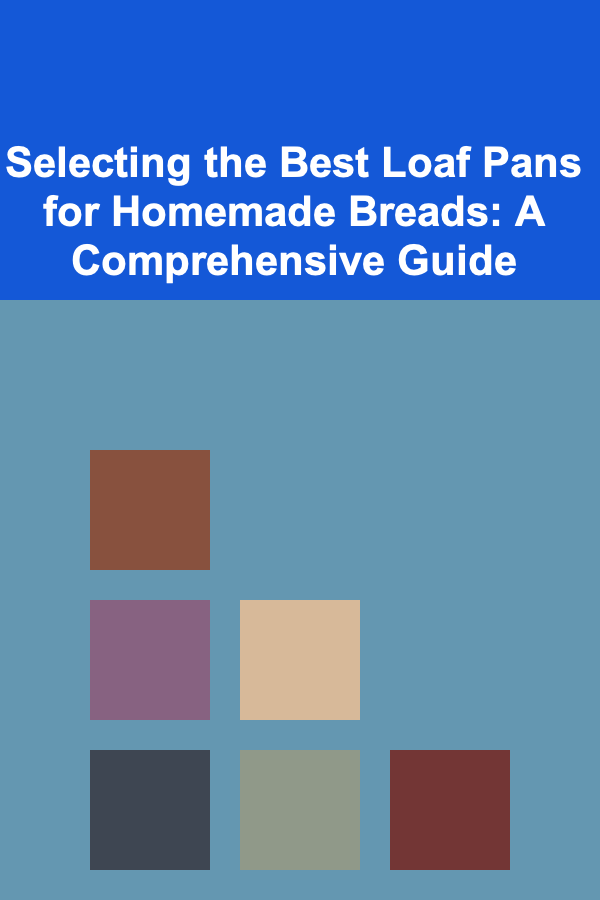
Selecting the Best Loaf Pans for Homemade Breads: A Comprehensive Guide
ebook include PDF & Audio bundle (Micro Guide)
$12.99$10.99
Limited Time Offer! Order within the next:

Baking homemade bread is a rewarding experience, filling your kitchen with the comforting aroma of warmth and deliciousness. However, achieving the perfect loaf isn't just about the recipe and technique; the choice of loaf pan plays a crucial role. Selecting the right pan can significantly impact the crust, crumb, rise, and overall texture of your bread. This comprehensive guide will delve into the key factors to consider when choosing the best loaf pans for your homemade baking adventures.
Understanding the Importance of Loaf Pan Selection
Many home bakers might overlook the importance of loaf pan selection, assuming that any pan will do. This is a common misconception. Different materials, sizes, and shapes impart different characteristics to the final loaf. A poorly chosen pan can result in uneven baking, a soggy bottom, a burnt crust, or even a collapsed loaf. Therefore, understanding the nuances of loaf pan characteristics is essential for consistently producing high-quality bread.
Impact on Crust Formation
The material of the loaf pan directly affects how quickly and evenly the crust forms. Darker pans, for example, absorb more heat and lead to a darker, crispier crust. Lighter pans reflect heat, resulting in a softer, more golden crust. The desired crust characteristic, whether you prefer a deeply caramelized crust or a softer one, should influence your pan material choice.
Influence on Crumb Structure
The shape and size of the pan influence the internal structure of the bread, also known as the crumb. A taller pan, for example, will encourage a higher rise, leading to a lighter and more airy crumb. A wider pan will promote a more dense and even crumb. The thermal conductivity of the pan material also affects the crumb. Pans that heat up and cool down quickly can lead to a more open crumb structure.
Effect on Baking Time
The material and thickness of the pan directly impact the baking time. Thicker pans distribute heat more evenly but may require a longer baking time. Darker pans, due to their higher heat absorption, may also require a slightly reduced baking time or a lower oven temperature to prevent burning. It's always best to monitor the internal temperature of the bread with a thermometer regardless of the pan used.
Key Factors to Consider When Choosing a Loaf Pan
Before purchasing a loaf pan, carefully consider the following factors to ensure you select the best option for your specific baking needs:
1. Material: The Foundation of Performance
The material of the loaf pan is arguably the most crucial factor determining its performance. Different materials offer distinct advantages and disadvantages regarding heat conductivity, durability, and ease of cleaning. Here's a breakdown of the most common materials:
a. Aluminum
Aluminum is a popular choice due to its excellent heat conductivity and even baking capabilities. It heats up quickly and distributes heat uniformly, minimizing hot spots and ensuring a consistently baked loaf. Aluminum pans are also relatively lightweight and affordable. However, aluminum can react with acidic ingredients, potentially discoloring the bread and imparting a metallic taste. Anodized aluminum pans offer a solution to this problem.
Pros:
- Excellent heat conductivity
- Lightweight
- Affordable
- Even baking
Cons:
- Can react with acidic ingredients
- May require greasing
- Can dent easily
b. Anodized Aluminum
Anodized aluminum undergoes an electrochemical process that strengthens the metal and creates a non-reactive surface. This makes it more durable, scratch-resistant, and less prone to reacting with acidic ingredients compared to standard aluminum. Anodized aluminum pans also tend to be darker in color, promoting a darker, crisper crust.
Pros:
- Excellent heat conductivity
- Durable and scratch-resistant
- Non-reactive
- Promotes a darker crust
- Even baking
Cons:
- More expensive than standard aluminum
- May still require greasing, though less often
c. Glass
Glass loaf pans offer excellent heat retention, which can result in a slightly longer baking time but also helps to ensure even baking. They allow you to monitor the browning process from all sides, preventing burning. Glass is also non-reactive, meaning it won't impart any unwanted flavors to your bread. However, glass is more prone to shattering due to thermal shock, and it doesn't conduct heat as efficiently as aluminum, potentially leading to a less crispy crust. Always place glass pans on a room temperature surface after removing them from the oven.
Pros:
- Excellent heat retention
- Non-reactive
- Allows for visual monitoring
Cons:
- Slower heat conductivity
- Prone to thermal shock
- Heavier than aluminum
- Can be difficult to release bread from
d. Silicone
Silicone loaf pans are known for their non-stick properties, making it incredibly easy to release bread without greasing. They are also flexible, allowing for easy removal of delicate loaves. Silicone is heat-resistant and can withstand a wide range of temperatures. However, silicone doesn't conduct heat as efficiently as metal, which can result in a softer crust and longer baking times. Silicone pans can also be flimsy and may require support when filled with batter.
Pros:
- Non-stick
- Flexible
- Easy to clean
- Heat-resistant
Cons:
- Poor heat conductivity
- Flimsy
- Can be difficult to clean thoroughly
- May impart a slight odor
e. Ceramic
Ceramic loaf pans offer excellent heat retention and distribution, similar to glass, promoting even baking. They are also aesthetically pleasing and can be used for serving. Ceramic is non-reactive and won't affect the taste of your bread. However, ceramic is heavy, fragile, and more expensive than other materials. It is also prone to chipping or cracking due to temperature changes.
Pros:
- Excellent heat retention and distribution
- Aesthetically pleasing
- Non-reactive
Cons:
- Heavy
- Fragile
- Expensive
- Prone to chipping or cracking
f. Non-stick Coating
Many loaf pans, regardless of their base material (usually aluminum or steel), come with a non-stick coating. This coating makes it easier to release the bread and simplifies cleaning. However, non-stick coatings can degrade over time, especially with frequent use and high temperatures. Scratches can also compromise the coating's effectiveness and potentially release harmful chemicals into your food. It is vital to use non-abrasive cleaning tools and avoid overheating non-stick pans.
Pros:
- Easy release
- Easy to clean
Cons:
- Coating can degrade over time
- Prone to scratches
- May release harmful chemicals if damaged
- Can hinder crust formation
g. Steel
Stainless steel is a durable and long-lasting option for loaf pans. It resists rust and corrosion, making it a reliable choice for years of baking. While stainless steel itself isn't a great conductor of heat, many stainless steel pans feature an aluminum core or a multi-clad construction to improve heat distribution. These pans offer a good balance of durability and performance, but can be more expensive than aluminum.
Pros:
- Durable and long-lasting
- Resistant to rust and corrosion
- Relatively easy to clean
Cons:
- Can be more expensive than aluminum
- Stainless steel alone doesn't conduct heat well (requires an aluminum core)
- Food can stick if not properly greased
2. Size and Shape: Tailoring to Your Needs
Loaf pans come in various sizes and shapes, each influencing the final loaf's dimensions and characteristics. Standard sizes range from 8.5x4.5 inches to 9x5 inches. Consider the following factors when selecting the size and shape:
a. Standard Loaf Size (9x5 inches)
The 9x5 inch loaf pan is the most common size and is suitable for most bread recipes, including sandwich bread, quick breads, and sweet loaves. This size provides a good balance between height and width, resulting in a well-proportioned loaf.
b. Smaller Loaf Size (8.5x4.5 inches)
Smaller loaf pans are ideal for smaller batches of bread, single servings, or when you want to create taller loaves. They are also suitable for baking bread machine recipes in the oven.
c. Pullman Loaf Pan
Pullman loaf pans are rectangular pans with straight sides and a lid. The lid creates a uniform, square-shaped loaf with a fine crumb and a soft crust. These pans are often used for making sandwich bread and toast.
d. Mini Loaf Pans
Mini loaf pans are perfect for individual servings or for gifting. They are available in various materials and shapes, allowing you to create adorable and portion-controlled loaves.
e. Specialty Shapes
Loaf pans are also available in various specialty shapes, such as round, fluted, or decorative designs. These pans are often used for baking cakes or decorative breads.
3. Thickness and Weight: Heat Distribution and Durability
The thickness and weight of the loaf pan affect its heat distribution and durability. Thicker, heavier pans tend to distribute heat more evenly, preventing hot spots and ensuring consistent baking. They are also more resistant to warping or denting. Thinner, lighter pans heat up quickly but may not distribute heat as evenly and can be more prone to damage. For example, a thin aluminum pan will dent easily, while a thick ceramic pan may be too heavy to comfortably handle.
4. Color: Crust Control
The color of the loaf pan influences how much heat it absorbs. Darker pans absorb more heat, leading to a darker, crispier crust. Lighter pans reflect heat, resulting in a softer, more golden crust. Consider your desired crust characteristics when choosing the color of your pan. For breads where a dark, caramelized crust is desired, a dark anodized aluminum pan is a good choice. For a softer crust, a glass or light-colored aluminum pan may be preferable.
5. Ease of Cleaning: A Practical Consideration
Cleaning can be a significant factor in the enjoyment of baking. Some materials, like silicone and non-stick coated pans, are incredibly easy to clean. Others, like aluminum, may require more effort. Consider your preferred cleaning method and the ease of maintenance when selecting a loaf pan. Dishwasher-safe options are convenient, but handwashing may be necessary to prolong the life of some pans, particularly those with non-stick coatings.
6. Price: Balancing Quality and Budget
Loaf pans range in price from affordable aluminum options to more expensive ceramic or stainless steel pans. Consider your budget and the frequency of use when making your decision. While investing in a higher-quality pan may be worthwhile for serious bakers, affordable options can still deliver excellent results for occasional baking. Often, a mid-range pan of a good material like anodized aluminum is the best compromise between performance and cost.
Tips for Using Your Loaf Pan
Once you've selected the perfect loaf pan, follow these tips to ensure optimal results:
1. Greasing and Flouring: Preventing Sticking
Unless using a silicone pan, always grease and flour your loaf pan before adding the dough. This will prevent the bread from sticking and ensure easy release. Use shortening, butter, or cooking spray to grease the pan thoroughly. For extra insurance against sticking, especially with breads containing a lot of sugar or molasses, dust the greased pan with flour, tapping out any excess.
2. Proper Dough Placement: Even Baking
Ensure that the dough is evenly distributed in the loaf pan to promote even baking. Gently press the dough into the corners of the pan and smooth the surface. Avoid overfilling the pan, as this can cause the dough to overflow during baking.
3. Oven Temperature and Baking Time: Achieving Perfection
Follow the recipe's instructions for oven temperature and baking time. However, keep in mind that oven temperatures can vary, so it's always a good idea to monitor the bread closely and adjust the baking time as needed. Use an oven thermometer to ensure accurate temperature readings. A digital thermometer inserted into the center of the loaf can confirm doneness; the internal temperature should reach the recommended temperature for the specific bread type, typically between 190-210°F.
4. Cooling: Allowing for Optimal Texture
Once the bread is baked, remove it from the oven and let it cool in the pan for a few minutes before inverting it onto a wire rack to cool completely. This will prevent the bread from sticking to the pan and allow the moisture to escape, resulting in a better texture.
5. Cleaning and Storage: Maintaining Your Pan
Clean your loaf pan immediately after use to prevent food from sticking. Use warm, soapy water and a non-abrasive sponge to clean the pan. Avoid using harsh chemicals or abrasive cleaners, as they can damage the pan's surface. Store your loaf pan in a dry place to prevent rust or corrosion.
Beyond the Basics: Advanced Considerations
For bakers who want to take their bread-making to the next level, here are some advanced considerations:
1. Preheating the Pan: Enhanced Crust
Preheating the loaf pan in the oven before adding the dough can result in a more even crust and a better rise. This technique is particularly effective with aluminum and anodized aluminum pans.
2. Using Baking Stones or Dutch Ovens: Professional Results
Placing a baking stone or using a Dutch oven inside the oven can help to create a more consistent baking environment and improve the crust and crumb of your bread. The baking stone absorbs heat and releases it evenly, while the Dutch oven traps steam, creating a moist environment that promotes a crispy crust.
3. Adjusting Recipes: Compensating for Pan Differences
If you switch between different loaf pans, you may need to adjust the recipe slightly to compensate for variations in size and shape. For example, if using a smaller pan, you may need to reduce the baking time or the amount of dough. Experimentation is key to finding the perfect adjustments for your specific pan.
4. Investing in Multiple Pans: Versatility and Efficiency
Consider investing in multiple loaf pans of different sizes and materials to increase your versatility and efficiency. This will allow you to bake different types of bread and experiment with various recipes and techniques. Having multiple pans also streamlines the baking process, allowing you to bake multiple loaves simultaneously.
Conclusion: The Right Pan for the Perfect Loaf
Choosing the right loaf pan is a critical step in the journey to baking perfect homemade bread. By carefully considering the material, size, shape, thickness, color, and ease of cleaning, you can select the pan that best suits your needs and preferences. Experiment with different pans and techniques to discover what works best for you and your favorite bread recipes. With the right pan and a little practice, you'll be able to consistently produce delicious and beautiful loaves that will impress your family and friends. Remember that baking is an art and a science, and the right tools, combined with passion and patience, will lead to culinary masterpieces. Happy baking!

Earning Money with AI: How to Make Passive Income with Deep Learning
Read More
How to Use Wall Space for Storing Lighter Gear
Read More
Overcoming Language Barriers Creatively
Read More
How To Offer Website Design Services: A Comprehensive Guide
Read More
Batching Similar Tasks for Time Efficiency: A Deep Dive
Read More
10 Tips for Keeping Your Ferret Cool in Summer
Read MoreOther Products

Earning Money with AI: How to Make Passive Income with Deep Learning
Read More
How to Use Wall Space for Storing Lighter Gear
Read More
Overcoming Language Barriers Creatively
Read More
How To Offer Website Design Services: A Comprehensive Guide
Read More
Batching Similar Tasks for Time Efficiency: A Deep Dive
Read More